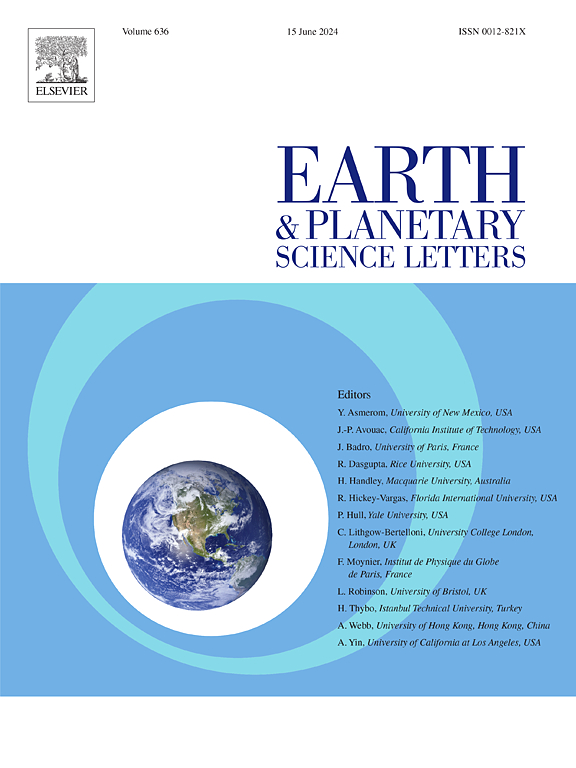Local sedimentary effects shaped key sulfur records after the Great Oxidation Event
IF 4.8
1区 地球科学
Q1 GEOCHEMISTRY & GEOPHYSICS
引用次数: 0
Abstract
Our understanding of Earth's surface oxidant budget following the Great Oxidation Event (GOE) relies heavily on interpretations of carbon (δ13C) and sulfur (δ34S) isotope ratios. Isotopic data have been used to argue that a rise in marine sulfate concentrations to >10 mM during the GOE was followed by a sulfate reservoir ‘collapse’. However, carbonate δ34S and δ13C values often reflect conditions specific to depositional setting and diagenetic alteration. To assess the relative importance of global vs. local/diagenetic controls, we present δ34S, δ26Mg, δ44/40Ca, and trace-metal data coupled with existing δ13C data from the ca. 2.1–2.0 Ga Tulomozero Formation and the overlying Zaonega Formation in the Onega Basin (Karelia, Russia). Over this transitional interval, δ34S and Sr/(Ca+Mg) values increase whereas δ13C and δ44/40Ca values decrease. X-ray absorption spectroscopy shows that the dominant form of sulfur within the rocks concomitantly shifted from mineralized sulfate and carbonate-associated sulfate (CAS) to variable mixtures of sulfide, sulfonate, and CAS. Those changes are associated with a depositional shift from shallow-marine to deeper-marine slope settings. δ44/40Ca and Sr/(Ca+Mg) data indicate that depositional environmental changes drove a shift from seawater- to sediment-buffered carbonate recrystallization. Consequently, we interpret δ34S trends that closely match those reported by previous workers as reflecting changing local environmental and diagenetic conditions, a finding that renders equivocal the use of such trends to assess sulfur cycle changes following the GOE. Our work establishes a blueprint for how to obtain deeper insight into the evolution of Earth's surface oxidation from stable isotope records.
当地沉积作用塑造了大氧化事件后的主要硫记录
我们对大氧化事件(GOE)之后地球表面氧化剂预算的了解主要依赖于对碳(δ13C)和硫(δ34S)同位素比值的解释。同位素数据被用来证明,在大洋环流期间,海洋硫酸盐浓度上升到 10 毫摩尔之后,硫酸盐储层 "崩溃"。然而,碳酸盐δ34S和δ13C值通常反映了沉积环境和成岩蚀变的具体条件。为了评估全球控制与局部/成因控制的相对重要性,我们将δ34S、δ26Mg、δ44/40Ca和痕量金属数据与来自约2.1-2.0 Ga T.C.的现有δ13C数据结合起来。在奥涅加盆地(俄罗斯卡累利阿)的 2.1-2.0 Ga Tulomozero 地层和上覆的 Zaonega 地层。在这一过渡区间,δ34S 和 Sr/(Ca+Mg)值上升,而 δ13C和 δ44/40Ca 值下降。X 射线吸收光谱显示,岩石中硫磺的主要形式从矿化硫酸盐和碳酸盐相关硫酸盐(CAS)同时转变为硫化物、磺酸盐和 CAS 的可变混合物。这些变化与沉积环境从浅海向深海斜坡转变有关。δ44/40Ca和Sr/(Ca+Mg)数据表明,沉积环境的变化推动了从海水缓冲碳酸盐再结晶到沉积缓冲碳酸盐再结晶的转变。因此,我们将与前人所报道的趋势非常吻合的δ34S趋势解释为反映了当地环境和成岩条件的变化,这一发现使利用这种趋势来评估GOE之后的硫循环变化变得模糊不清。我们的工作为如何从稳定同位素记录中更深入地了解地球表面氧化作用的演变提供了一个蓝图。
本文章由计算机程序翻译,如有差异,请以英文原文为准。
求助全文
约1分钟内获得全文
求助全文
来源期刊

Earth and Planetary Science Letters
地学-地球化学与地球物理
CiteScore
10.30
自引率
5.70%
发文量
475
审稿时长
2.8 months
期刊介绍:
Earth and Planetary Science Letters (EPSL) is a leading journal for researchers across the entire Earth and planetary sciences community. It publishes concise, exciting, high-impact articles ("Letters") of broad interest. Its focus is on physical and chemical processes, the evolution and general properties of the Earth and planets - from their deep interiors to their atmospheres. EPSL also includes a Frontiers section, featuring invited high-profile synthesis articles by leading experts on timely topics to bring cutting-edge research to the wider community.
 求助内容:
求助内容: 应助结果提醒方式:
应助结果提醒方式:


